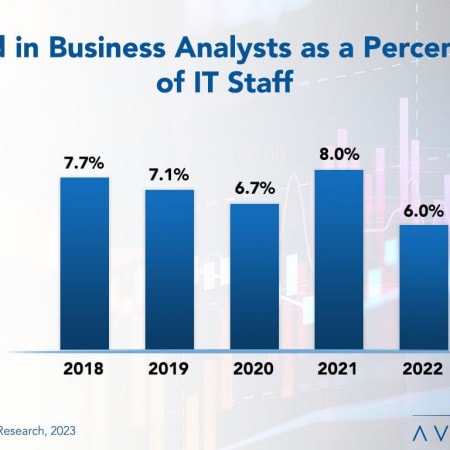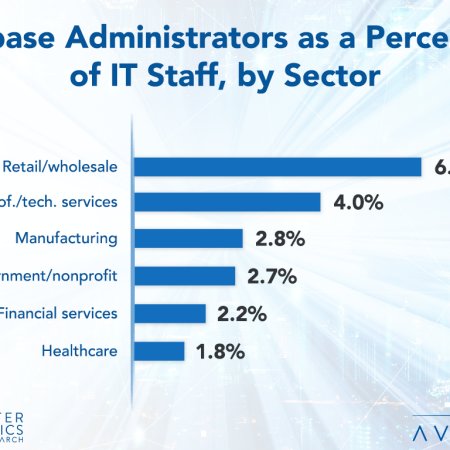-

Network Support Staffing Ratios 2023
The COVID-19 pandemic increased the number of employees working from home. This accelerated an already increasing demand for network support staff brought on by cloud transformation and caused the number of network support personnel to spike in 2021. However, 2022 trends show a decrease in network support staffing to below pre-pandemic levels. This may be due to businesses reverting to “normal” operations, an increase in automation, a growth in other IT areas, or a combination of these and other factors.
May, 2023
-

Business Analyst Staffing Ratios 2023
The business analyst staffing ratio appears to be declining, but the role is not falling in importance. Therefore, as business users become more IT-savvy, it is only natural that business analysts would increasingly be rising up within the business rather than in the IT organization. The Research Byte summarizes our full report on business analyst staffing ratios.
February, 2023
-

Factors Affecting DBA Staffing Ratios
Database administration (DBA) staffing remained steady in 2022, even though organizations are capturing and analyzing greater amounts of data. One reason DBA staffing levels are not rising is technology, specifically AI/ML, which is assisting DBAs in collecting, sorting, managing, and controlling ever-larger volumes of data. This Research Byte summarizes our full report on database administration staffing ratios.
January, 2023
-

Network Support Staffing Ratios 2021
Computer networks are more important than ever. Although the level of network support staffing has plateaued in previous years, there are signs of resurgence. This report will help IT managers determine whether their organization is keeping pace with improvements in network management by comparing their network support staffing ratios against industry benchmarks. We provide four benchmarks: network support staff as a percentage of the IT staff, network support staff as a percentage of the Network and Communications Group, network devices per network support staff member, and users per network support staff member. We provide benchmarks by organization size and sector. We conclude with recommendations for optimizing the cost of network support staff.
December, 2021
-

Hybrid Work Stimulating Demand for Network Support Personnel
Although the level of network support staffing plateaued in previous years, there are now signs of resurgence. This is largely the result of the COVID-19 pandemic, with remote and hybrid work styles increasing the demand for network support personnel. This Research Byte summarizes the five-year trend in network support staffing ratios.
December, 2021
-

Business Analyst Staffing Ratios 2021
Business analysts as a percentage of the IT staff has risen from its previous decline, and we expect that this will be the trend. The business analyst serves as a bridge between the IT organization and business users. It is a multifaceted role that is important for ensuring that IT application systems meet business objectives. In this study, we assess staffing levels for the business analysts using four metrics: business analysts as a percentage of the IT staff, business analysts as a percentage of the delivery group, applications per business analyst, and users per business analyst. We also present ratios by organization size and sector.
November, 2021
-

Database Administration Staffing Ratios 2021
As enterprises collect more data and connect more applications, they must ensure that data is secure, reliable, and accessible. But despite these increased demands, companies are restraining the growth in their database administration staff. This report helps IT managers determine whether they are keeping pace with industry standards by providing four benchmarks: database administrators (DBAs) as a percentage of the IT staff, DBAs as a percentage of the Data Center Group, users per DBA, and business applications per DBA. We present benchmarks for small, midsize, and large organizations and examine the influence by sector on these benchmarks. We conclude with best practices for optimizing DBA staffing.
October, 2021
-

Retailers Feeling the Need for More Database Administrators
: While database administration (DBA) staffing remains steady or has declined in most sectors, the retail/wholesale sector has increased staffing in this area. The COVID-19 pandemic elevated the importance of an online presence in the retail/wholesale sector. This Research Byte provides a summary of our full report on database administration staffing ratios.
October, 2021
-

IT Project Management Staffing Ratios 2021
In this study, we assess how many project managers a typical IT organization requires. We present five benchmarks: project managers as a percentage of the IT staff, project managers as a percentage of the application group, users per project manager, applications per project manager, and application programmers per project manager. Our analysis also includes the influence of organization size and industry sector. We conclude with recommendations on assessing the performance of the project management function.
May, 2021
-

IT Project Manager Staffing Marches to New High
As IT organizations move more of their operations to the cloud, the mix of required skills needed is changing, with most infrastructure-support roles falling as a percentage of the staff, and higher-level roles rising. Project management is one job position that has been steadily increasing over the past five years. This research byte discusses what is behind the rise and provides a summary of our full report on IT project management staffing ratios.
May, 2021
-

Server Support Staffing Declines as IT Organizations Shed On-Premises Infrastructure
The demand for server support administrators has been declining over the past decade, and this trend will continue. Why the decline? Cloud computing is allowing IT organizations to reduce their on-premises data center infrastructure, while virtualization and automation are making the servers that remain on-premises easier to administer. This Research Byte summarizes the five-year trend in server support staffing ratios.
February, 2019
-

ERP Support Staffing Ratios 2016
In this study, we analyze ERP support requirements by means of a simple ratio: the number of ERP users per ERP support staff member. The higher the ratio, the more productive the support personnel appear to be, all other things being equal. We assess this ratio by size of installation, sector, maturity of installation, and upgrade frequency. We then compare ratios for Oracle E-Business and SAP ERP systems with the composite ratio for all other systems. Finally, we provide recommendations on optimizing staffing levels. (16 pp., 6 fig.) [Research Byte]
May, 2016
-

Application Programmer Staffing Ratios
With the changing IT environment, IT organizations can benefit from a periodic assessment of their application programmer staffing levels. This study uses three metrics to benchmark this function: application programmers as a percentage of the IT staff, users per application programmer, and applications per application programmer. We provide benchmarks for the composite sample, by organization size, and by sector. We also provide a benchmark for the larger Application Group, which includes all personnel engaged in developing and maintaining applications. (19 pp., 9 fig.) [Research Byte]
April, 2016
-

Server Support Staffing Ratios 2015
Server support personnel have been declining as a percentage of the typical IT staff. How many server support staff members does an organization need? To answer that question, we provide four key benchmarks: server support staff as a percentage of the IT staff, users per server support staff member, physical servers per server support staff member, and OS instances per server support staff member. We provide these metrics for small, midsize, and large organizations. We also assess how industry sector can influence server support staffing ratios. We conclude with recommendations for improving server support productivity. (17 pp., 8 fig.) [Research Byte]
September, 2015
-

ERP Support Staffing Ratios 2015
In this study, we analyze ERP support requirements by means of a simple ratio: the number of ERP users per ERP support staff member. The higher the ratio, the more productive the support personnel appear to be, all other things being equal. We assess this ratio by size of installation and sector. We also report median ratios for Oracle E-Business, SAP ERP, PeopleSoft, and JD Edwards systems vs. all others. Finally, we provide recommendations on optimizing staffing levels after assessing the influence of age of installation, number of instances, number of versions, extent of modifications, and scope of functionality. (14 pp., 5 fig.) [Research Byte]
August, 2015

 Grid View
Grid View List View
List View